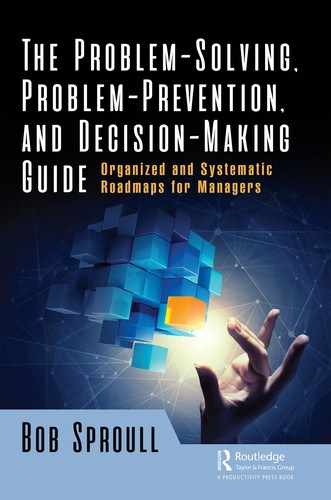13Defining High-Risk Areas
Living at risk is jumping off the cliff and building your wings on the way down.
Ray Bradbury
13.1Identify the High Risk or Vulnerable Areas of Your Organization
Our first action toward our look into the future starts with an identification of areas within our organization or plant or a specific process that could be at risk or vulnerable. These are areas that could be potential showstoppers for your organization. They can be specific processes, systems, or even strategies that could negatively impact the long-term viability and profitability of your company or facility. In this activity you are asking questions like, Which part of our business or plant has the potential to go awry and cause us problems and why? or What areas in our business or plant could cause us problems in the future and why? The questions need to be open-ended and require more than just a yes or no response. Remember, we are trying to identify areas of high risk.
Examples of high-risk areas could be something like having a single supplier of raw materials or parts, or maybe maintenance services if you contract out your maintenance. Other typical examples might be hourly labor or potential labor contract disputes, the pricing of your products, your research and development organization, your customers, or any other part of your business or plant. Remember, in this step, we are only trying to define and identify areas within the business that could go wrong and not the actual potential problems. That will come next.
Identification of these high-risk areas, in many cases, involves critically and openly looking at future strategies, plans, or proposed changes, and then trying to imagine what could go wrong if the plan or change wasn’t successful. A good technique is to first develop a step-by-step project management plan, and then review each important step or milestone for what could go wrong. We should be especially critical of anything that the organization has never done before or things outside the current core competency. If there is a time constraint involved, it is even more important to focus on that activity. Every plan or strategy contains linchpins or critical factors that control the eventual success or failure of any project. Linchpins are the glue that holds plans together, and if they are removed, the plans could come crashing down, so you should focus on them.
Now that you have created your list of areas of vulnerability, it’s time to select the one (or two) that will have the biggest impact on the organization. Impact, in this case, could be things like loss of revenue, loss of jobs, vulnerability to lawsuits, loss of capacity, and inability to supply goods and services.
In this step, we are looking at potential problems from ten thousand feet. That is, we are using our intuition and logic to whittle our list to a manageable size of, say, two or three potential problems. One simple way to do this is to consider the following two elements:
The chances of the event going wrong
The overall negative impact on the organization
Table 13.1 is a simple tool that any organization can use to select the right area of vulnerability. We are considering the potential negative consequences facing the organization and the chances of the negative event actually happening. Each potential problem or negative event is rated as low, medium, or high, for both occurrence and consequences, and placed directly into the appropriate box within the table. As you might have speculated, any potential negative event or proposed project that falls within a red box should be selected. Conversely, any event or area that falls within a green block should be crossed off the list. The yellow blocks are borderline and represent those events that may or may not be included on your final list.

Once your most important areas of vulnerability have been defined and consensus has been achieved, it is now time to define the potential problems, failure modes, and potential negative effects that could occur in these areas.
